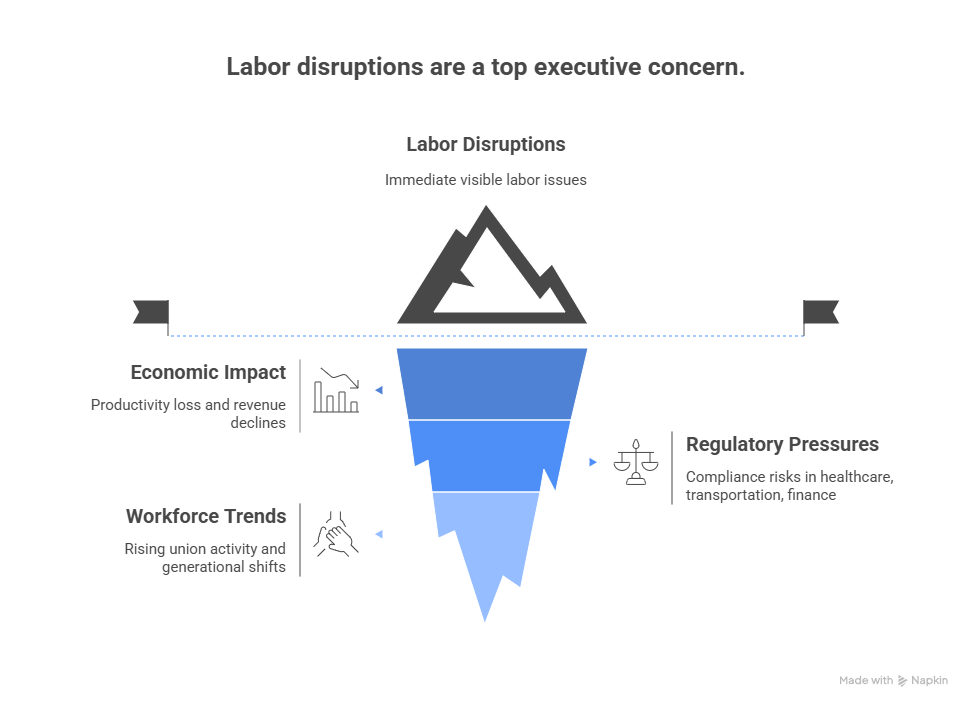
Why Continuity Planning Matters More Than Ever
Labor disruptions are no longer rare, one-off events. From union strikes and walkouts to sudden absenteeism during public health crises, businesses face increasing threats to their workforce stability. According to a 2024 Bureau of Labor Statistics report, the United States saw over 4 million workdays lost due to labor disputes alone — a number that continues to rise as economic pressures and worker advocacy gain momentum.
For executives, operations managers, and HR leaders, these disruptions represent not just a staffing challenge but an operational and reputational risk. Delayed deliveries, halted production lines, or unstaffed healthcare facilities can erode customer trust and create compliance liabilities.
That’s why a continuity plan template for labor disruptions is essential. Unlike generic business continuity frameworks, this plan zeroes in on workforce instability and offers a structured way to prepare, respond, and recover.
What Is a Continuity Plan for Labor Disruptions?
A continuity plan for labor disruptions is a structured strategy that outlines how a business will maintain critical operations when labor resources are reduced, unavailable, or withdrawn. While broader continuity plans often focus on IT systems, natural disasters, or financial risks, this one is laser-focused on people.
Key Characteristics:
- Proactive Preparation: Identifies essential roles, cross-training opportunities, and potential vendor partnerships before a disruption occurs.
- Operational Prioritization: Highlights which business functions must remain running at all costs versus those that can be temporarily paused.
- Workforce Flexibility: Leverages temporary staffing, automation, or subcontracting to bridge labor gaps.
- Communication Framework: Ensures clarity with employees, clients, regulators, and stakeholders.
Think of it as a playbook: when a strike, shortage, or walkout hits, leadership won’t scramble. Instead, they’ll turn to a documented guide that reduces downtime and protects profitability.
Why Labor Disruptions Are an Executive Priority
Executives and operations managers cannot afford to treat labor issues as isolated HR problems. The ripple effects stretch across supply chains, customer relationships, and compliance obligations.
Economic Impact
- Lost Productivity: Even a 10% reduction in labor can slow output by 20–30% in industries like manufacturing and logistics.
- Revenue Losses: Retailers and service providers face direct losses as hours shorten or customer service quality drops.
- Market Reputation: In an era of instant online reviews, failure to staff operations can tarnish brand image overnight.
Regulatory Pressures
- Healthcare: Hospitals must meet staffing ratio laws; noncompliance can trigger fines or license jeopardy.
- Transportation: Trucking and airline industries face federal labor safety and hours-of-service mandates.
- Financial Services: Compliance teams must stay operational to satisfy regulatory reporting deadlines.
Workforce Trends
- Union Activity Rising: The U.S. saw a 50% increase in strike activity from 2022 to 2024.
- Gig Economy Risks: Overreliance on flexible workers can backfire if platforms face sudden regulatory changes.
- Generational Shifts: Younger employees often prioritize work-life balance and may be less tolerant of overtime-heavy disruption strategies.
In short, executives must integrate continuity planning for labor disruptions into their broader risk management playbook.

A Practical Continuity Plan Template for Labor Disruptions
The following template is designed for business leaders to adapt directly into their operations. It balances strategic oversight with tactical steps that managers can implement quickly.
1. Risk Assessment & Workforce Mapping
Step 1: Identify Critical Functions
- List all business processes and rank them by importance to revenue, safety, and compliance.
- Highlight functions that cannot operate without human involvement (e.g., patient care, machine operation).
Step 2: Map Workforce Dependencies
- Chart out which teams, departments, or specific roles are essential to each function.
- Identify single points of failure (e.g., only one certified technician for a key machine).
Step 3: Evaluate External Risk Factors
- Assess union contracts, upcoming negotiations, or labor relations issues.
- Monitor regional labor market data to anticipate shortages in specialized roles.
Key Takeaway:
Without knowing exactly where your labor risks sit, continuity planning becomes guesswork. This stage gives executives visibility into vulnerabilities before disruption hits.
2. Staffing Alternatives and Partnerships
Internal Measures:
- Cross-Training: Build redundancy by training staff across multiple functions.
- Overtime Protocols: Pre-approve overtime arrangements to cover short-term gaps.
External Measures:
- Staffing Agencies: Establish pre-negotiated contracts with temporary labor providers.
- Subcontractors: Build relationships with secondary vendors who can step in.
- Automation: Identify tasks that could be temporarily automated with existing technology.
3. Communication & Stakeholder Management
Disruptions without communication quickly spiral into crises. A continuity plan must define who communicates what, to whom, and when.
Core Elements:
- Employee Messaging: Transparent updates on the nature of disruption, expected timelines, and interim measures.
- Customer Outreach: Proactive notices about adjusted delivery schedules or service levels.
- Regulatory Reporting: Timely communication with compliance agencies if staffing ratios or deadlines are impacted.
- Executive Alignment: Daily or weekly check-ins for leadership teams to adjust strategies.
Checklist for Communication Plan:
- Assign spokespersons for internal and external communication.
- Prepare pre-drafted templates for strike announcements, staffing adjustments, or regulatory updates.
- Establish multi-channel communication: email, text alerts, intranet, and customer portals.
4. Operational Adjustments
Not all disruptions can be absorbed by staff augmentation alone. Businesses often need to restructure how they operate.
Possible Adjustments:
- Reduced Hours: Temporarily shorten service hours to maximize productivity with available staff.
- Prioritized Services: Focus on critical clients or contracts and defer non-essential work.
- Supply Chain Adjustments: Work with suppliers to stagger or slow deliveries.
This section of the plan ensures that even in reduced capacity, quality and compliance don’t collapse.
5. Recovery and Post-Disruption Review
Even with a well-executed continuity plan, the true test of resilience comes after operations stabilize. Leaders must evaluate not only how effectively the disruption was managed, but also how to strengthen the plan for the future.
Recovery Priorities:
- Operational Catch-Up
- Address backlogs in production, logistics, or customer service.
- Use staggered overtime or flexible scheduling to avoid burning out returning staff.
- Financial Impact Assessment
- Track revenue lost during the disruption.
- Quantify additional expenses from staffing agencies, overtime, or automation.
- Reconcile costs against business interruption insurance (if applicable).
- Reputation Rebuilding
- Launch outreach campaigns to reassure customers and partners.
- Address negative press or online reviews with transparent communication about corrective actions.
- Employee Relations
- Reengage employees who participated in or were affected by the disruption.
- Rebuild morale through town halls, recognition programs, or HR listening sessions.
Post-Mortem Checklist:
- What went well in the execution of the plan?
- Where were bottlenecks or breakdowns?
- Which functions recovered quickly, and which lagged?
- How can lessons learned be incorporated into future planning?
By documenting this systematically, the continuity plan becomes a living document — not a static binder on a shelf.
6. Scenario Planning and Stress Testing
No two labor disruptions are alike. A short-term sick-out is vastly different from a months-long strike. That’s why scenario planning is a cornerstone of this continuity plan template.
Common Scenarios to Test:
- Short-Term Absenteeism Spike: 20% of staff unavailable for 5–10 days.
- Union Strike: Key departments walk out for 30–90 days.
- Logistics/Driver Shortage: 40% of scheduled deliveries missed for two weeks.
- Healthcare Staffing Crisis: Ratios fall below regulatory minimums for a sustained period.
Stress Testing Methods:
- Tabletop Exercises: Leadership teams walk through a hypothetical disruption using the plan as a guide.
- Simulations: IT or HR runs a “mock disruption” by disabling certain systems or role availability.
- External Audit: Engage a third-party consultant to review and validate the plan.
Key Takeaway: Testing the plan under multiple scenarios prevents executives from relying on a single “best-case” playbook.
7. Monitoring, Metrics, and Continuous Improvement
An effective continuity plan must be measurable. Otherwise, leaders risk assuming preparedness without proof.
Metrics to Track:
- Response Time: How quickly did leadership activate the plan?
- Downtime Duration: How long were critical operations affected?
- Financial Losses Avoided: Compare projected losses without a plan versus actual losses.
- Employee Engagement: Monitor morale and turnover rates post-disruption.
Tools & Systems:
- HR Analytics: Real-time dashboards showing absenteeism and turnover.
- Operations KPIs: Track production, fulfillment, or service levels.
- Incident Management Software: Centralize communications, task assignments, and recovery timelines.
Continuous Improvement Loop:
- Test and measure.
- Record findings.
- Update template.
- Retrain teams.
Embedding this loop into the plan ensures it adapts as the labor landscape evolves.
8. Continuity Plan Template: Sample Framework
Below is a ready-to-use framework that executives and managers can adapt to their organization.
Continuity Plan Template for Labor Disruptions
- Executive Summary
- Brief outline of plan purpose and scope.
- Risk Assessment
- Critical functions inventory.
- Workforce dependency mapping.
- External labor risks (e.g., union contracts, market shortages).
- Staffing Alternatives
- Cross-training programs.
- Pre-arranged agreements with staffing agencies.
- Automation opportunities.
- Communication Plan
- Employee updates.
- Customer notifications.
- Regulatory obligations.
- Operational Adjustments
- Reduced hours.
- Prioritization of contracts or clients.
- Supply chain modifications.
- Recovery Strategy
- Backlog resolution.
- Financial impact assessment.
- Reputation rebuilding.
- Monitoring & Improvement
- KPIs and reporting cadence.
- Scenario planning and stress testing.
- Post-mortem reviews.
Appendices:
- Contact lists (executive, HR, union reps, staffing agencies).
- Pre-drafted communication templates.
- Compliance checklists.
This template gives decision-makers a scaffold to build from rather than starting from scratch.
(FAQ’s)
What is a continuity plan template for labor disruptions?
A continuity plan template for labor disruptions is a structured document that outlines how an organization will maintain critical operations when its workforce is partially or fully unavailable. Unlike general business continuity plans, this template specifically addresses risks like strikes, absenteeism spikes, or staffing shortages. It covers risk assessment, staffing alternatives, communication strategies, operational adjustments, and recovery.
Why is continuity planning important during strikes or labor shortages?
Because labor disruptions directly impact operations, they pose immediate financial, reputational, and regulatory risks. A single week of halted production or unstaffed services can lead to millions in lost revenue, fines, or long-term customer churn. Continuity planning gives executives a proactive framework to minimize downtime and maintain trust with clients and regulators.
Who should be involved in creating the continuity plan?
A cross-functional team is critical:
- Executives: Provide strategic direction and resource allocation.
- Operations Managers: Identify critical functions and dependencies.
- HR & Labor Relations: Manage workforce communication and union negotiations.
- Finance: Track cost implications and insurance coverage.
- IT & Compliance: Ensure monitoring systems and regulatory obligations are integrated.
How often should the continuity plan be updated?
At minimum, the plan should be reviewed annually. However, organizations in highly unionized, heavily regulated, or labor-dependent industries should review it after:
- Major contract negotiations.
- Significant turnover or workforce restructuring.
- A real-world disruption event.
What are examples of operational adjustments during labor disruptions?
Operational adjustments may include:
- Reducing service hours.
- Prioritizing essential contracts or clients.
- Outsourcing specific tasks temporarily.
- Staggering supply chain orders.
The goal is to maximize efficiency with available staff while avoiding regulatory noncompliance.
How can technology support continuity planning?
Technology enhances resilience by:
- Automating routine processes (e.g., payroll, scheduling).
- Providing real-time workforce dashboards.
- Offering communication platforms for crisis updates.
- Simulating disruption scenarios through modeling software.
From Planning to Preparedness
In an era where labor disruptions are becoming more frequent and costly, executives and operations leaders cannot afford to ignore workforce continuity planning. A well-structured continuity plan template for labor disruptions transforms uncertainty into a manageable risk.
By proactively assessing workforce dependencies, securing staffing alternatives, creating communication frameworks, and running scenario tests, organizations can weather even the most significant disruptions with minimal impact.
Recommended Next Steps for Leaders:
- Engage Cross-Functional Teams: HR, operations, finance, and compliance should co-own the plan.
- Run a Tabletop Exercise: Stress-test the plan under a realistic disruption scenario.
- Update Regularly: Integrate lessons learned and evolving labor market data.
With preparation comes resilience. With resilience comes competitive advantage. Businesses that embrace continuity planning today will be the ones that maintain trust, compliance, and market share when disruptions inevitably strike.









